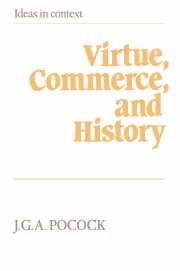 Virtue, Commerce, and History
Virtue, Commerce, and History Book contents
- Frontmatter
- Contents
- 1 Introduction: The state of the art
- PART I
- PART II
- 5 Modes of political and historical time in early eighteenth-century England
- 6 The mobility of property and the rise of eighteenth-century sociology
- 7 Hume and the American Revolution: The dying thoughts of a North Briton
- 8 Gibbon's Decline and Fall and the world view of the Late Enlightenment
- 9 Josiah Tucker on Burke, Locke, and Price: A study in the varieties of eighteenth-century conservatism
- 10 The political economy of Burke's analysis of the French Revolution
- PART III
- Index
8 - Gibbon's Decline and Fall and the world view of the Late Enlightenment
Published online by Cambridge University Press: 05 May 2010
- Frontmatter
- Contents
- 1 Introduction: The state of the art
- PART I
- PART II
- 5 Modes of political and historical time in early eighteenth-century England
- 6 The mobility of property and the rise of eighteenth-century sociology
- 7 Hume and the American Revolution: The dying thoughts of a North Briton
- 8 Gibbon's Decline and Fall and the world view of the Late Enlightenment
- 9 Josiah Tucker on Burke, Locke, and Price: A study in the varieties of eighteenth-century conservatism
- 10 The political economy of Burke's analysis of the French Revolution
- PART III
- Index
Summary
In that otherwise memorable year, 1776, Edward Gibbon published the first volume of The Decline and Fall, carrying the narrative to the conversion of Constantine and concluding with the two famous chapters on the rise of Christianity. In 1781, he published the second and third volumes, carrying the narrative to the deposition of Romulus Augustulus and concluding with a chapter which anatomizes Merovingian Gaul, Visigothic Spain, and Anglo-Saxon Britain, and is itself closed by what is really a separate essay – the “General Observations on the Fall of the Roman Empire in the West.” The three remaining volumes – which are concerned less with the Latin-Germanic West than with the “world's debate” between Byzantium and Islam in the East – did not appear until 1788. Gibbon died in 1794, at the outset of what would otherwise have been an exile from his beloved Lausanne occasioned by the wars between old Europe and revolutionary France. These dates reveal that The Decline and Fall is in chronology a product of the last years of the Enlightenment, the uneasy years between the American and French revolutions; this essay will examine the respects in which it is that also in spirit.
- Type
- Chapter
- Information
- Virtue, Commerce, and HistoryEssays on Political Thought and History, Chiefly in the Eighteenth Century, pp. 143 - 156Publisher: Cambridge University PressPrint publication year: 1985


